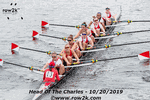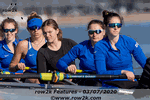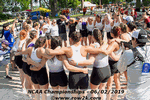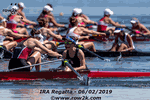Rowing Technique Part 3 - Style Changes
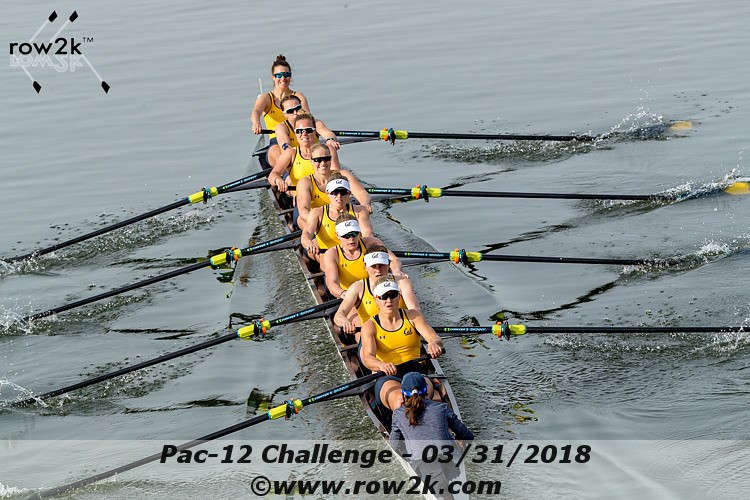
Following the cancellation of the 2020 spring racing season, row2k solicited the collegiate coaching community to engage in a variety of high-level topics within the profession. We submitted over sixty questions across a dozen topics and thank the coaches and staffs that found time to contribute their thoughts during this stressful time.
This week we focus on the topic of Technique with the following question:
HOW OFTEN HAVE YOU CHANGED YOUR TECHNICAL STYLE AND WHAT HAVE BEEN THE DRIVING FORCES BEHIND MAKING THOSE CHANGES?
AL ACOSTA – CALIFORNIA, BERKELEY WOMEN
I don't think there have been huge or abrupt style changes, it's more like little things creep in and slowly we're emphasizing something different and then maybe over time it's a "style change." I think if you have a super talented rower on the team, she can also influence the team's "style." I see this in other teams throughout the years and I'm sure it happens with teams that I work with as well. The "super talented rower influence" would probably influence the rhythm more than "style." Uh, oh... Rhythm and style debate alert! But I do think the rowers learn a lot from each other. Every young kid these days is trying to shoot like Steph Curry.
ALICEA STRODEL – MINNESOTA WOMEN
I’ve been lucky enough to work with and around great coaches who all emphasized different parts of the drive and the recovery. Listening, observing, reading and ultimately trial and error have narrowed my view of what is technically important.
BART THOMPSON – ADRIAN
I was taught a very “fast hands” technique in high school, and through the early part of my rowing career that was considered the norm. When I began coaching is when the shift in hand speed towards the “gather” became more popular. At first, I thought it was a bit odd looking and wondered how it could make sense. Then I looked at the data and saw the “why” behind it, saw that the numbers supported it being a faster style if done correctly, so I began to gravitate towards that style.

However, I’ve realized in coaching that the “gather” style requires a very high-level athlete; they need a strong core to hold the finish and not collapse, as well very precise timing on the front end or you’ll slam into the catch. As such, I’ve pulled back from that style a bit with certain teams I’ve coached. It doesn’t do much good to emulate a style if you don’t have the rowing ability to implement it effectively.
KEMP SAVAGE – EASTERN MICHIGAN WOMEN
I have not changed my technical style. Based on watching a lot of national team videos of multiple countries, it isn't the style that is faster or slower, but the coordination of all the athletes and the ability of the athletes that define the success of a type of style.
HEATHER BARNEY – TRINITY WOMEN
I think all of us have some consistent core to what we teach, maybe a favorite part of the stroke that we feel especially strong at teaching or just really enjoy executing ourselves when we’re in the boat. My stroke has always been heavily focused towards the front end, and I’ve always LOVED watching my athletes really deeply connect at the top of the slide. That said, I’ve definitely gained new appreciation for other parts of the stroke over time which has certainly changed my technical emphasis. Usually the impetus for me is another coach I’m working with who’s able to show me a different side of the stroke and a new way to see it and teach it.
A season working with Greg King at National Cathedral School really highlighted for me the way that you can carry that front-end connection into massive acceleration through the mid-drive and back-end to create a stroke that’s much more dynamic than what I had originally been teaching. By the same token, work with my current assistant, Julie Warren, as well as my own college coach and mentor Justin Moore, has highlighted for me the speed gains available through better organization and awareness on the recovery.
I think it’s important when assembling a staff to find other coaches who speak a similar language to yourself around the stroke, but also to be very open to folks who are “in love” with a different part of the stroke than you are. If you can influence each other to a more well-rounded technique, so much the better for your program. Similarly, taking the opportunity to ride along with other coaches whenever possible with a critical but open eye towards understanding what they teach differently from you can be hugely helpful.
ANONYMOUS HEAD COACH
I was taught to row with fast hands and body out of the bow. I rowed that way my entire college career, it is what I knew, and I coached that “style” for probably four or five years once I began coaching. My “style” is now much more centered on letting the boat run out after the release, being patient with the hands out of bow, and less forward body angle before allowing the knees to rise. This came about from watching top collegiate crews, watching national team video, and listening to the arguments as to why this style would be preferred by some. To me, it seemed to make more sense. Now, I made the change for myself, but there are many fast crews out there that prefer a different style, which means there’s a lot to be said with getting your blade in the water and what you do with it after that.
JENN LANGZETTEL – DUQUESNE WOMEN’S ROWING
Once; recently the pause at the release is something that a lot of programs have adopted. I do not agree with it but worked with it a little a couple falls ago. It is a good reinforcer of maintaining engagement and pick up through the finish, but I now only use it as a drill rather than our style. I view the stroke as a continuous motion and consistently pausing breaks up the flow of the stroke.
DAN ROOCK – DARTMOUTH LIGHTWEIGHT MEN
The basics have never changed. I’ve dabbled a bit with the degree of body swing through to the release, which can be more or less effective depending upon a rower’s source of power.
BRIAN DAWE – TUFTS
My style has not changed much over the years, except to adapt details to the oars and rigging possibilities. I started coaching small women in large men’s Pocock eights with very limited rigging adjustments in the early 70’s. The idea has always been to move the boat past the blade using the weight of the body. The biggest effect of adjustable tracks/shoe plates has been to bring the body up taller coming forward. Most crews from those times looked overextended by comparison to now. Oddly, despite the oar differences (Macon blades on 382cm to Fat2s on much shorter lengths) the spread and inboard are almost the same.
ETHAN SHOEMAKER – STETSON
We talk almost exclusively about being “fundamentally sound” here at Stetson. We spend almost all of our technical energies on our hips, hands and heels. How our crews “look” coming down the course is not as important to us as how effectively they are moving the boat. This is a big change from what I used to teach. When I first started coaching, I used to think that a fast boat rows poetic. Over time I have come to understand that the majority of what is effective in moving the boat is not what we talk about when it comes to “style.” This has been a fundamental change for me in how I teach the rowing stroke, but it has been the only real change in what I believe is most effective for moving the boat down the course.
TODD KENNETT – CORNELL HEAVYWEIGHT MEN
I have an idea of what I want the stroke to look like. Then as we go through the beginning of the season and the athletes begin to turn in performances, I often find a few of my athletes who are the best strokes, they have good rhythm, a knack for racing, good boat sense, and I will fit my style of stroke to them. Then I try to make the rest of the crew fit that person to create a boat. Rather than try to change that athlete a lot (assuming they do the majority of what I am looking for) I will adapt the crew to the stroke. So, over the years we have had subtle differences in style, but nothing too crazy.

Each crew is different. Some are stronger, some are longer, some can row higher, so depending on the group, something is always different. For this reason, I may change what I stress. We may do a drill and all of sudden the whole boat gets the right motion so we will fall back to that drill frequently and use that to be our rally point. But that changes throughout the year, let alone between different seasons.
The basic stroke has not changed a lot for me, but where and how I teach the stroke is always evolving and is just different with that year’s crew. Also watching other crews, other coaches, national teams always give you new ideas, but I have to be careful before I implement what I saw, meaning I need to make sure I understand why a crew is doing something. Some crews lay way back, other stay upright, is one right or wrong? That is why I do not change suddenly unless I fully understand why they are doing it, and then work to figure out if it really can help my crew before we try to change what we have been working on all season.
MEGAN COOKE CARCAGNO – DUKE WOMEN
I’ve changed styles quite a bit, but it always boils down to preparation and balance as the keys for taking the stroke you would like to take. A lesson I constantly teach is length always wins (length in the water). The skill level, size, and strength of the crew will necessitate different variations of recovery and drive focuses but being in a stable position to apply pressure together efficiently is always the goal.
JIM LISTER – HAMILTON
Generally, staying with the same style. I think adapting the weight room or what I refer to as functional movement to come into the rowing movement. How do you lift something? Well, let's do that on the erg and boat.
ERIC GEHRKE – GEORGE WASHINGTON MEN
I feel we are all constantly updating our technical style in small ways as we learn and improve our eye. I have made larger overhauls to my technical model three times in twelve years – adding a “gather” to our lower rate work (roughly 2011), changing the height at which we carry the handle through the recovery (roughly 2014), and adjusting our drive sequencing to be more ‘athletic’ but still leg-centric (roughly 2017).
CAMPBELL WOODS – MARIST MEN
I have definitely changed the style that I coach dramatically since I began coaching with the big change being to move the collecting point of the athletes from the arms and body over position to the finish. My personal change in preference can be owed to a) watching the way faster crews row b) personal experimentation in the single and rowing in a variety of different crews c) discussion with athletes and coaches about what they think about the topic and why.
I think that the presence of the internet has opened us up to the wider array of different crews and the ability to dissect how other teams are rowing has definitely caused an evolution in the stroke. I also think that dynamic ergometers like RP3, Oartech, and C2 + C2 on slides have pushed this conversation further.
BILL ZACK – SAN DIEGO STATE
I don’t think I have changed my technical style so much as I have changed what I think is most important. I used to focus most of my technical coaching on recovery dynamics. I figured that if you could put your oar in the water properly, how hard could it be to pull on the handle? Now I spend most of my time focusing on the mechanics of the drive, especially a good first third of the drive. I think the change is in part from becoming a more enlightened and knowledgeable coach, but also the change to hatchet blades and stiffer boats and new technology that lets you actually know what is happening during the stroke.
ANONYMOUS HEAD COACH
Don’t change the winning crew. I don’t change because one team won. We stick to our guns and teach what we believe. As long as your entire crew is doing the same thing your crew will be successful. I have watched crews miss a foot of water and still win. This is because everyone in the boat was doing the same thing and they were moving together. If I change my style every year (layback, slow hands, fast hands, rush into the catch, pause at the catch) because one team won then I will never teach my kids good consistent skills. Coaches need to realize they are never 100% correct but you can’t change every single year. The reality is we are not comparing apples to apples. If we had the exact same people in every boat, then technique would be easy. You have to realize my team is totally different (different ergs, different heights, different everything) so I can’t just compare my team on one aspect.
If you enjoy and rely on row2k, we need your help to be able to keep doing all this. Though row2k sometimes looks like a big, outside-funded operation, it mainly runs on enthusiasm and grit. Help us keep it coming, thank you! Learn more.
Comments | Log in to comment |
There are no Comments yet
| |
- Bont Rowing
- Calm Waters Rowing
- Concept 2
- Craftsbury Sculling
- The Crew Classic
- CrewLAB
- Croker
- Dad Vail Regatta
- Durham Boat Co.
- Empacher
- Faster Masters
- Filippi
- Fluidesign
- h2row.net
- HUDSON
- Live2Row Studios
- Nielsen-Kellerman
- Oak Ridge RA
- Peinert Boat Works
- Pocock Racing Shells
- Race1 USA
- RowKraft
- Rubini Jewelers
- Vespoli USA
- WinTech Racing
- Bont Rowing
- Calm Waters Rowing
- Concept 2
- Craftsbury Sculling
- The Crew Classic
- CrewLAB
- Croker
- Dad Vail Regatta
- Durham Boat Co.
- Empacher
- Faster Masters
- Filippi
- Fluidesign
- h2row.net
- HUDSON
- Live2Row Studios
- Nielsen-Kellerman
- Oak Ridge RA
- Peinert Boat Works
- Pocock Racing Shells
- Race1 USA
- RowKraft
- Rubini Jewelers
- Vespoli USA
- WinTech Racing









